From Kamigamo and Shimogamo shrines to Daitokuji temple and Botanical Gardens
Audio guide of 13 selected sightseeing spots in the Kamigamo / Shimogamo area
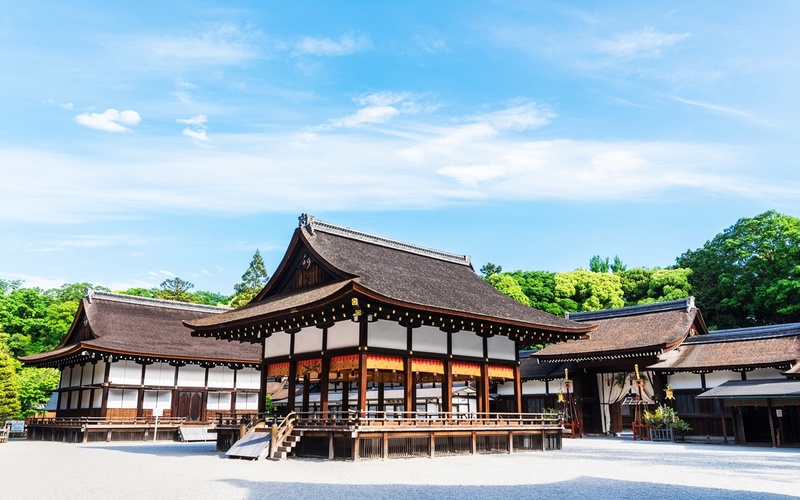
Exploring the Kamigamo・Shimogamo area
Here, we bring you to an area forming a triangle that crosses over the Kamogawa river, with the Kamigamo-jinja Shrine to the north, Funaokayama mountain to the west and Shimogamo-jinja shrine to the east. Kamigamo-jinja Shrine and Shimogamo-jinja Shrine, which enshrine the god Kamouji, are two of the oldest shrines in Kyoto. Since they house numerous national treasures and important cultural assets as well as are world heritage sites themselves, visitors come here from all around the world.
In the lower left of the triangle, this southern part of the Kita-ku area is called "Murasakino" and in the Heian period, it was aristocratic hunting grounds. Funaokayama mountain is located here, which is regarded as the "Genbu" guardian god. It is also known as the guardian of the north in the capital of Kyoto, and Imamiya-jinja shrine and its many shrines are also located here in this vast area.
Compared with the Arashiyama and Shijo areas that are crowded throughout the year, this area is relatively quiet and easy to wander around for sightseeing. Depending on the season and the time of the day, there are temples you can visit in serenity. On the other hand, if you want to visit a bustling city nearby, Kitayama, which is located right of the center of the triangle, is highly recommended. There, you will find great date spots as well as many popular cafés and grocery stores.
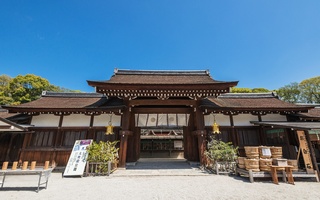
A Shimogamo-jinja Shrine (Kamomioya-jinja)
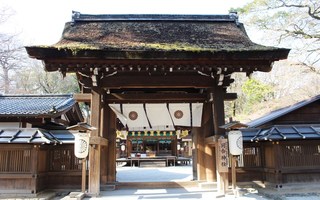
B Kawai-jinja Shrine
C Kyoto Botanical Gardens
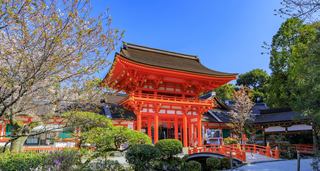
D Kamigamo-jinja Shrine (Kamo-wake-ikazuchi-Jinja)
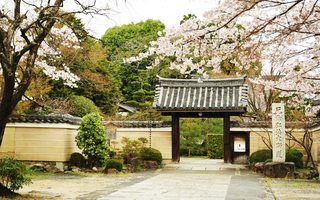
E Jinko-in Temple
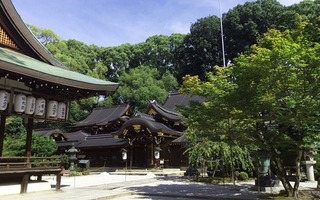
F Imamiya-jinja Shrine
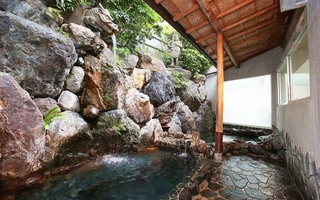
G Funaoka-onsen Hot springs
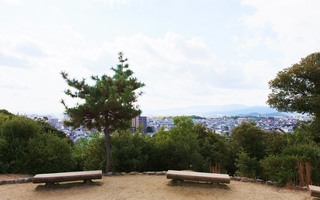
H Funaokayama Park
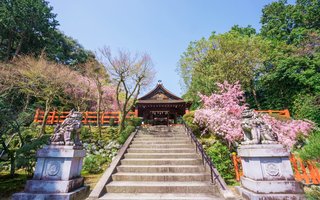
I Takeisao-jinja Shrine (Kenkun-jinja Shrine)
A
Shimogamo-jinja Shrine (Kamomioya-jinja)

"Tadasu-no mori" forest is where trees hundreds of years old grow thick. Shimogamo-jinja shrine calmly stands at the end of this sacred forest and was originally part of the Kamigamo-jinja shrine. Although the exact date of construction is unknown, it is believed that it was built before the Nara era and originally large scale.
The two main halls located to the east and the west are listed as national treasures. Most of the shrine is designated as an important cultural asset, mostly built or rebuilt in the early Edo period. Among them and open to the public is the "Ooi-dono," a kitchen that cooks offerings for the gods using grains such as rice and mochi. Here, you can see an exhibit displaying reproductions of traditional offerings and cooking utensils. Even in Japan, a shrine of this kind is still very rare and it is a valuable cultural asset where you can get a glimpse of Japan's unique food culture. In the precincts, there are several village shrines of various beliefs, such as the marriage god “Aioi-no yashiro," the guardian deity of protection "Kotosha" that the village is known for worshipping, and the protector from disasters "Inoue-sha." Shimogami-jinja Shrine is famous for Mitarashi dango rice dumplings, but the "Saruya" area has revived its "Sarumochi rice cake" and they are becoming a hot commodity as it was served exclusively during the Aoi Festival until the beginning of the Meiji era.
B
Kawai-jinja Shrine

Kawai-jinja Shrine, located on the southern side of the "Tadasuno-mori forest," is known as a power spot and a popular place among women. It is also known as the "Kamo-no Kawa-aini-imasu okosohe-jinja shrine." The building is small, but it was formerly the head shrine of Shimogamo Shrine, where sacred ceremonies were performed for the mother of Emperor Jinmu, "Tamayori hime-no-mikoto" (Empress Tamayori), who was the very first emperor of Japan. Empress Tamayori was known for her beauty and is now considered a guardian of women, watching over childbirth, marriage, and beauty. For women who want to be beautiful, you can draw the face you want to have on the "Kagami-ema" in hopes your wish will come true. On the west side of the precinct is the small sub-shrine "Tobe-sha." Because the festival's Yata-garasu-no Mikoto is a symbol of the Japan Football Association, visitors found here are often praying for their favorite team to win. Additionally, there is a replica of the hut where famous author Kamo no Chomei spent his last years. The hut is about 3 square meters big and the story Kamo no Chomei wrote while residing here is called “Houjyou-ki.” “Houjyou" a term used in the "Ichijyou-shihou" measurement system. Kamo no Chomei was born to a family that served Shimogamo-jinja Shrine and hoped to serve this Kawai-jinja Shrine, which was also called "Tadasu-no yashiro" at the time, but alas, it was not meant to be. As for the real hut, its believed location is marked by a huge stone called "Houjyou stone" on Hinoyama mountain of Fushimi.
C
Kyoto Botanical Gardens
Kyoto Botanical Gardens was the first of its kind open to the public in 1942 in Japan. Located in a flat area in the northern part of the city, this garden is surrounded by beautiful scenery, with Mount Hie mountain of Higashiyama mountain range to the east, the clear waters of the river Kamo to the west, and the beautiful mountain range of Kitayama to the north. Approximately 12,000 kinds of plants can be found on the sprawling site of about 240,000 square meters for you enjoy the colors of the seasons.
In the spring, cherry blossoms of 150 varieties, including Yoshino cherry tree and Yebenishidare, will bloom for about a month. Autumn leaves are a sight to behold in the fall. Formosan gum trees with hydrangea over a hundred years old are also spectacular. Various exhibitions are held throughout the year, including those on Western orchids and chrysanthemums. The greenhouse in the garden is one of the largest in the country, and you can see tropical plants and the rarest kinds in the world all in one place. Among them, there are day-to-night rooms where you can see flowers that only bloom at night, bringing you a magical evening in the middle of the day. There are also alpine plant rooms where you can see various alpine plants from Japan and all around the world. If you have time, please also visit the "Kyoto Prefectural Ceramic Art Painting Garden" next to Kitayama Gate. General admission to both gardens are also on sale.
D
Kamigamo-jinja Shrine (Kamo-wake-ikazuchi-Jinja)

Kamigamo-jinja Shrine is one of the oldest shrines in Kyoto. Since the ancient times, its connection to the Imperial court is very strong with its Aoi Festival in May, boasting a history of more than 1000 years. During the festival, people dressed in Heian aristocratic costumes walk along with carts, cattle and horses decorated with Aoi leaves, and its magnificent parades are often compared to those in Heian Picture Scrolls, depicting unseen traditional courtyard events around the country. In the precincts, when you pass through the second Torii gate, you will see two sandstands in front of the "Hosodono" hall. These are referred to as " Tatezuna " and represent the Koyama, which is a shinto object of worship. Pine needles standing at the top of the sandstone is a guide directing the gods where to descend. Pine needles have two leaves at the right, three leaves on the left. Three leaves is very rare, and if you are lucky you may see it in the precincts. For a small fee, you can visit the main hall of this national treasure. Kata-yamano Miko shrine, known as the god of marriage, is a popular spot for female visitors. In addition, you can rejuvenate yourself by taking in the natural scenary, such as the Shoukei-en garden, imitating the garden of the late Heian period and small river streams passing through the trees. If you have time, please also visit " Shake-machi Town." A " Shake " is a family that serves the gods. This district of traditional houses is clustered along the eastern side of a torii gate and the Myojin-gawa river.
E
Jinko-in Temple

Jinko-in Temple was founded in the Kamakura period. It is said that the priest of Kamigamo-jinja Shrine received a message from a god saying "Build in the land illuminated by Reiko" so he built a temple by transferring one of the buildings of Kamigamo-jinja Shrine here. Since it is derived from this vision, the temple’s name utilizes the character "Shin," meaning god. The principal image of Buddha is the Kobo Daishi statue. In the Heian era, Kobo Daishi Kukai carried out a 42-year training period and carved his own figure with wood. In addition to this temple, there are Toji Temple, Nin-naji Temple which has connections with Kukai, and Kyoto has a custom of praying for protection by worshiping these three temples called "Kyo no Sankou Koubou Meguri." Also, in Kyoto, where there are many events related to vegetables. Jinko-in is famous for "cucumber sealing" held every July where guests are invited to wrap a cucumber with a prayed paper with their name, age and health issues written on it and tie it with the string of Mizuhiki. It was believed that if then you rub that cucumber on the infected part of your body and bury it in the ground, you will soon be cured. "Ren-getsu-an," nestled in the lush greenery, is a tea room where potter and poet Otagaki Rengetsu spent his last years at the end of the Tokugawa period. " Rengetsu ware ", which are ceramics with Ridgetsu's poems written on it, is said to have become very popular as a souvenir of Kyoto.
F
Imamiya-jinja Shrine

During the Heian period, epidemics ravaged the capital city of Kyoto. Imamiya-jinja Shrine was built by the inauguration of the Spiritual Association to quell the plague in this Murasakino area. The shrine served as a place of prayer for the plague to stop until its closure following the end of the warring states period. It was Keishoin that restored this. Keishoin was a daughter of Nishijin's greengrocer who became one of the wives of the third Shogunate, Iemitsu Tokugawa. She later gave birth to General Tsunayoshi Tokugawa, the fifth shogunate. She was devoted in her faith, and restored the shrine as it was believed to be house to the god of her hometown, and she donated the halberd for the festival, through which she made great efforts to revive the city. The "Yasurai Matsuri" and "Imamiya sai Festival," which are held to pray for a life free of disease, are celebrated today still because of the belief that this festival will also calm the god of poverty.
Orihime shrine is another shrine within the precincts and worships the god of textiles in hopes of improving ones weaving skills. There are also many registered tangible cultural properties to be seen and places worth visiting such as the wondrous "Ahokashi-san" stone. It is said that if you are not feeling well, rub this stone over the source of pain and it will be healed. As for the rest, the specialty "Aburi mochi" rice cakes come highly recommended. Two famous mochi shops sit face to face before the east gate: the oldest teahouses in Japan "Ichimonjiyawasuke," established during the Heian period, and "Kazariya," which was founded in 1637. On the south side of Imamiya-jinja Shrine, there is Daitokuji temple, an old temple of the Rinzai sect, that you should stop by as well.
G
Funaoka-onsen Hot springs

Funaoka-onsen Hot springs was founded as a gourmet inn called "Funaoka-ro" in 1923. After that, in 1951, it introduced Japan's first electric baths and became "Special Funaoka Onsen." Funaoka onsen, along with the Kyoto’s public bath house, is a popular spot among tourists. "Funaoka Onsen" is a hot spring in name, but it is not a natural one. It is the building that attracts people. First, there is the entrance. At a glance, it is not something you see in an ordinary public bath. The heavy gate surrounded by a huge stone wall was built in 1928 when this place was still a gourmet inn. The sculptures decorating the ceiling of the dressing room are Ushiwaka maru and Kurama Tengu. This public bath features a mural of Kuramaguchi, an artwork based on the legend of Kurama Tengu teaching Ushiwakamaru how to wield a sword. Rare majolica tiles color the walls of the washbowl and the bathhouse. Even after hundreds of years, the color of the tiles don’t seem to fade. The interior of the rooms are considered works of art and were was registered in 2003 as tangible cultural properties of the country. Next to this building, there is a former barber shop of Funaoka Onsen that has been designated as a cultural heritage site, and on the side wall, there is a remnant of a plaque from when it was renamed "Special Funaoka Onsen" in 1933.
H
Funaokayama Park

Funaokayama Park, built in 1931 on Funaokayama mountain overlooking Kyoto, is a place for locals to relax in its plazas and for children to play on its playgrounds. It lies about 112 meters above sea level. The observation deck of the park is known as a night view spot with its view of the cityscape of Kyoto including Kyoto Tower. This small mountain-like hill also played an important role in history. When building Heiankyo, the town was created symmetrically in the east and west, centered on the Suzaku Boulevard landing to the south of Funaokayama, and the guardian god to the north. In the mid-Heian period, this area was a cemetery where many royalty and commoners were buried. Even now, at the foot of the mountain there is a district called "Enma-maecho" meaning devil city, which indicates that this land was considered a bridge to the other world. During the Muromachi period, competition for this mountain was fought over during the Ōnin War.The monument of "Ōnin & EishōEra Battlefield Monument " is to inform visitors that battle at Funaokayama took place in 1511. After that, this mountain was handed over to Daitokuji by Hideyoshi Toyotomi and worshiped as the spiritual place of Nobunaga Oda. At the Kenkun-jinja Shrine at the East end, the deity of the shrine is dedicated to Nobunaga as well as his son Nobutada.
I
Takeisao-jinja Shrine (Kenkun-jinja Shrine)

This shrine's official name is Takeisao-jinja Shrine, but it is also known as the Kenkun-jinja Shrine. This shrine is to worship the god of fulfillment of major warfare, breaking through, and good fortune. The deity is dedicated to Nobunaga Oda to commemorate the way he lived his life as he pushed forward bravely and unwaveringly towards the unification of Japan. The deity enshrined here is also related to Nobunaga's vassal, Hideyoshi Toyotomi. After Honnō-ji Incident, where Nobunaga lost his life, Hideyoshi performed Nobunaga' s Buddhist memorial service at Daitokuji. In addition, Hideyoshi tried to build a temple dedicated to Nobunaga in Funaokayama, but the plan was scrapped. Although the temple was not built, this mountain was regarded as the spiritual place of Nobunaga. Then, as the Meiji era was ushered in, by the decree of Emperor Meiji, a shrine was built here for Nobunaga's accomplishment which ended the period of Sengoku, or the warring states era, and forged the path to unite Japan as one. A highlight of this shrine is the hall of past worshippers, where portraits of Nobunaga and 18 warriors of Sengoku hang. If you look closely, you’ll find the family crest of the Oda family carved on the side of the pedestal of the main pillar and the shrine dog, in addition to the simplistic beauty of the main hall and the hall of worship based on traditional Japanese architecture, "Oda mo-kou".